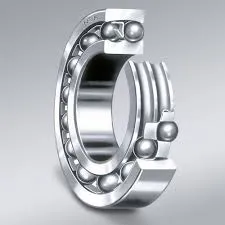
Oct . 13, 2024 00:40 Back to list
Exploring Various Types and Applications of Thrust Bearings in Engineering
Types of Thrust Bearings An Overview
Thrust bearings are a crucial component in various mechanical systems, designed to support axial loads and provide guidance to rotating shafts. Their main function is to handle the axial forces that can act along the shaft's axis, which is prevalent in many applications ranging from automotive to industrial machinery. This article details the main types of thrust bearings, their applications, and their advantages.
1. Ball Thrust Bearings
Ball thrust bearings consist of ball elements placed between two rings. They are particularly suited for low to moderate load applications. The design allows for smooth operation and efficient load transfer, making them ideal for use in machinery where space is limited. Ball thrust bearings are commonly found in automotive applications, such as in the clutches of manual transmissions and in applications that require consistent speed with minimal friction.
2. Roller Thrust Bearings
Unlike ball thrust bearings, roller thrust bearings utilize cylindrical rollers. This design provides a larger contact area, which allows them to handle higher loads. Roller thrust bearings are highly efficient and suitable for applications involving heavy, axial loads. They're often used in applications such as industrial gearboxes, marine propulsion systems, and various heavy machinery. Their ability to manage substantial loads makes them favorable in sectors where reliability and performance are essential.
3. Tapered Roller Thrust Bearings
Tapered roller thrust bearings are designed with tapered rollers arranged in a way that allows them to handle both axial and radial loads. This unique design makes them highly versatile for applications where varying force directions are present. They are commonly employed in applications such as automotive wheel hubs, where they can manage the complexities of cornering forces while maintaining stability and performance.
types of thrust bearings

4. Fluid Thrust Bearings
Fluid thrust bearings, including hydrostatic and hydrodynamic varieties, use a film of lubricant (liquid or gas) to support the moving parts. These bearings excel in high-speed and high-load applications, creating little to no friction during operation. Hydrostatic bearings rely on an external source to maintain the lubrication film, while hydrodynamic bearings generate film pressure through the motion of the components themselves. Fluid thrust bearings are particularly common in high-speed turbine applications, aerospace technology, and specialized industrial processes.
5. Magnetic Thrust Bearings
Magnetic thrust bearings utilize magnetic fields to support the shaft without physical contact, virtually eliminating friction. This technology is often utilized in applications where traditional bearings would fail under extreme conditions or where maintenance must be minimized. Magnetic thrust bearings find their place in electric motors, high-speed rotating equipment, and advanced healthcare technology. Their ability to handle high speeds while minimizing wear makes them an innovative choice for modern engineering challenges.
6. Spherical Thrust Bearings
Spherical thrust bearings are used to accommodate slight misalignments between the shaft and housing. With a design featuring spherical elements, these bearings can handle axial loads while allowing for angular displacement. They are commonly found in applications where alignment issues may arise, such as in cranes and heavy lifting equipment. Their flexibility and strength make them indispensable in various engineering sectors.
Conclusion
Choosing the right thrust bearing is essential for ensuring the longevity and efficiency of mechanical systems. Each type of thrust bearing has its unique advantages and applications, allowing engineers to select the most appropriate one based on the specific requirements of their machinery. Whether it's the compactness of ball thrust bearings or the high-capacity solutions provided by roller thrust bearings, understanding these options leads to better performance and reliability in engineering design and applications. As technology advances, the efficiency and capability of thrust bearings continue to evolve, promising exciting innovations for the future.
Latest news
-
Premium Deep Groove Ball Bearings | High Speed & Reliability
NewsAug.29,2025
-
Durable Scaffolding Clamps - Secure & Reliable Tube Connectors
NewsAug.28,2025
-
Common Failures in Thrust Ball Bearings and Solutions
NewsAug.22,2025
-
How Tapered Roller Bearings Can Take Shock Loads
NewsAug.22,2025
-
Angular Bearings in High-Precision Spindles
NewsAug.22,2025
-
The Impact of Misalignment on Cylindrical Roller Bearing Performance
NewsAug.22,2025
